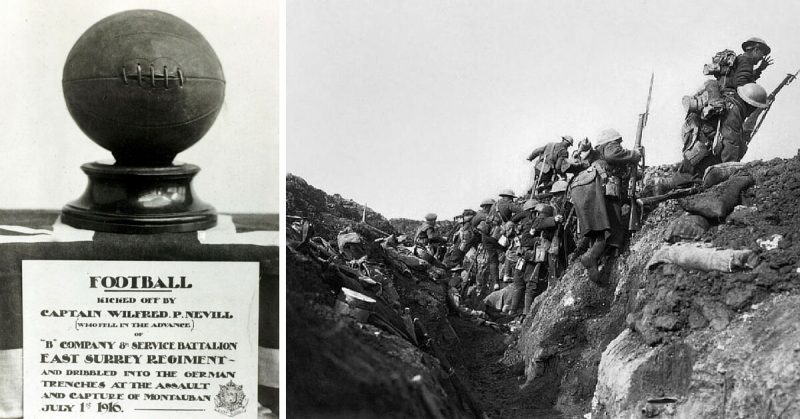A French collector is reportedly preparing to sell a priceless football used by soldiers on the front lines of World War I during the Battle of Somme. The leading contender for the purchase is said to be the United Manchester football club. If this ends up happening, the ball will be back on English soil for the first time in 100 years.
“I might be ready to part with it if they twist my arm,” said Dominique Zanardi, who first received an offer from United in 1998. That was the year that the 54-year-old collector found the ball near where the 18th Battalion of the Manchester Regiment attacked on July 1st, 1916.
“It was in a rubbish dump in the village of Coin, near Albert,” said Mr. Zanardi. “A farmer who had housed members of the regiment had died, and his grandchildren were clearing his house. They were set to burn everything, including the ball, but I managed to retrieve it. A rucksack in which the ball was found was stamped 18th Manchesters.”
Zanardi thought he had found a flattened rugby ball until he inflated it. “The ball was from Gamages, the London department store, and had probably been bought by mail order,” he said.
Mr, Zanardi, who runs Tommy’s Cafe and Museum at Pozières, said, “I was contacted by Manchester United about acquiring the ball, but turned them down at the time.”
But now, with the centenary of the Battle of the Somme approaching on July 1st, 2016, he said he had changed his mind. “Now I might well let it go. I’m not going to live forever, and I would like to think it will be revered and kept safe for future generations. Why not in Manchester?”
Asked about how valuable he thought the ball might be, Mr. Zanardi said, “How can you value something that is unique, and so historic? It’s priceless.”
The Manchesters were on the front lines next to the East Surrey Regiment, who are famous for charging into battle while kicking a football in what is known as the “football charge”. Captain Wilfred “Billie” Nevill was trying to relax his men as they went. He thought kicking the balls toward the enemy line might take their minds off of the machine gun fire. Nevill bought two footballs while on leave in London and brought them with him back to France.
His unit reached their objective, but Nevill was struck down. He had been told by his superiors to “walk, not run” as they believed that the enemy defenses had been neutralized. His bravery inspired the poem which includes the lines:
On through the hail of slaughter
Where gallant comrades fall
Where blood is poured like water
They drive the trickling ball
The fear of death before them
Is but an empty name
True to the land that bore them
The Surreys played the game
Peter Jones, who runs the Single Step battlefield tours company, said, “The Manchester ball has been kept behind the bar at Tommy’s for many years, and is in very good condition. The Billie Nevill story is extremely moving, and very well known, but work is still needed to find out the exact history of the Manchester ball.”
It’s identical to the two that were recovered from the Surreys. One of those was destroyed by a fire in the Queen’s Royal Surrey Regimental Museum near Guildford last year. The other is at the Prince of Wales’ Royal Regiment Museum at Dover Castle.
